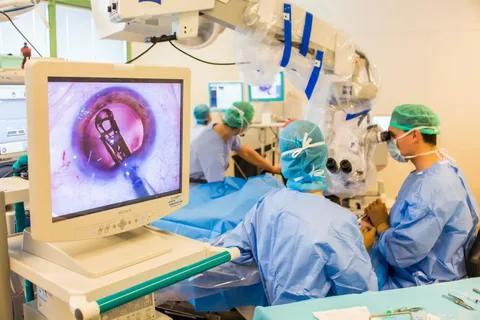P
Presbyopia, the age-related condition that gradually reduces the ability to focus on close objects, affects millions of people worldwide. Most of them begin experiencing its effects in their early to mid-40s and turn to reading glasses or bifocals for help. Corrective lenses are the traditional treatment, but they do nothing to address the underlying biological changes that occur in the eye as it ages.
Over the past few years, researchers have been investigating a range of innovative presbyopic therapies for restoring near vision and reducing dependence on glasses. From pharmaceutical eye drops to advanced surgery, the field of presbyopia treatment is evolving rapidly. These pipeline drugs hold the potential to transform eyesight in aging patients.
Pharmaceutical Eye Drops
One of the most thrilling areas of research is presbyopia-correcting eye drops. These topical drugs change the size of the pupil for a short duration, increase the depth of focus, and improve near vision. First trials have discovered that some drops could restore a number of hours of improved reading ability without compromising distance vision significantly.
Researchers are also examining formulations to make the lens more flexible or improve the performance of ocular muscles. These measures are aimed not only to cause temporary relief, but to target the biological changes responsible for presbyopia. If it succeeds, drug solutions could offer a non-surgical and simple solution over glasses.
Corneal Inlays and Implants
A second research area is the development of corneal inlays—tiny pieces of technology implanted in the cornea to improve near vision. The inlays work by altering the path that light takes into the eye so that there is a greater depth of focus. While some of the first-generation designs proved problematic for clarity and patient satisfaction, new designs are being evaluated with improved materials and optics.
Researchers are also developing reversible or removable presbyopic solutions, giving patients more freedom to decide if the surgery is suitable for them. Such advancements could expand surgical possibilities for individuals looking for long-term correction of presbyopia without relying on external lenses.
Lens-Based Approaches
Because presbyopia is essentially a loss of flexibility of the natural lens, treatments in relation to the lens make up a large portion of the research. Multifocal and accommodating intraocular lenses (IOLs), which are often used during cataract surgery, are being developed further to focus more clearly at various distinct distances. Accommodating IOLs, particularly, are designed to move or change shape within the eye, mimicking the natural focusing ability lost with presbyopia.
Next-generation IOLs should progress outcomes by reducing glare, halos, and other vision complaints sometimes associated with current multifocal lenses. These improvements offer patients more natural vision correction with surgical solutions.
Upcoming Presbyopic Treatments May Revolutionize Eye Healthcare
Presbyopia may be inevitable with age, but advances in research are promising more effective treatments. From drops and inlays in the cornea to groundbreaking lenses and surgery, the pipeline is filled with promising new developments.
As the treatments work their way through clinical trials and approval procedures, they hold the potential to reduce the demand for reading glasses and improve the quality of life for millions. The future of presbyopia treatment could be dramatically different, offering patients options far beyond the corrective lenses of the past.





Be First to Comment